Diagnosing Improper Membrane Water Content in Proton Exchange Membrane Fuel Cell Using Two-Dimensional Convolutional Neural Network
Abstract
1. Introduction
2. Methods
2.1. Data Pre-Processing
2.2. 2D Data Generation Technique
2.3. CNN Model Used in the Research
2.4. Feature Separability Analysis
3. Description of PEMFC Tests and Corresponding Test Data
4. Effectiveness of the Proposed Method in Identifying Improper Membrane Water Content of the PEMFC
5. Conclusions
Author Contributions
Funding
Institutional Review Board Statement
Informed Consent Statement
Data Availability Statement
Conflicts of Interest
References
- Lipman, T.E.; Edwards, J.L.; Kammen, D.M. Fuel cell system economics: Comparing the costs of generating power with stationary and motor vehicle PEM fuel cell systems. Energy 2004, 32, 101–125. [Google Scholar] [CrossRef]
- Lv, X.Q.; Wang, Y.D.; Qin, C.; Liu, G. A comprehensive review on hybrid power system for PEMFC-HEV: Issues and strategies. Energy Convers. Manag. 2018, 171, 1273–1291. [Google Scholar]
- Reddy, K.J.; Sudhakar, N. ANFIS-MPPT control algorithm for a PEMFC system used in electric vehicle applications. Int. J. Hydrog. Energy 2019, 44, 15355–15369. [Google Scholar] [CrossRef]
- Beneito, R.; Vilaplana, J.; Gisbert, S. Electric toy vehicle powered by a PEMFC stack. Int. J. Hydrog. Energy 2007, 33, 1554–1558. [Google Scholar] [CrossRef]
- Rahimi-Esbo, M.; Ranjbar, A.A.; Rahgoshay, S.M. Analysis of water management in PEM fuel cell stack at dead-end mode using direct visualization. Renew. Energy 2020, 162, 212–221. [Google Scholar] [CrossRef]
- Zhou, F.; Andreasen, S.J.; Kar, S.K.; Yu, D.H. Analysis of accelerated degradation of a HT-PEM fuel cell caused by cell reversal in fuel starvation condition. Int. J. Hydrog. Energy 2015, 40, 2833–2839. [Google Scholar] [CrossRef]
- Park, S.; Shao, Y.Y.; Viswanathan, V.V.; Liu, J.; Wang, Y. Non-kinetic losses caused by electrochemical carbon corrosion in PEM fuel cells. Int. J. Hydrog. Energy 2012, 37, 8451–8458. [Google Scholar] [CrossRef]
- Wu, J.F.; Yuan, X.Z.; Martin, J.J.; Wang, H.J.; Zhang, J.J.; Shen, J.; Wu, S.H.; Merida, W. A review of PEM fuel cell durability: Degradation mechanisms and mitigation strategies. J. Power Sources 2008, 184, 104–119. [Google Scholar] [CrossRef]
- Vasilyev, A.; Andrews, J.; Dunnett, S.; Jackson, L. Dynamic reliability assessment of PEM fuel cell systems. Reliab. Eng. Syst. Saf. 2021, 210, 107539. [Google Scholar] [CrossRef]
- Bahrebar, S.; Zhou, D.; Rastayesh, S.; Wang, H.; Blaabjerg, F. Reliability assessment of power conditioner considering maintenance in a PEM fuel cell system. Microelectron. Reliab. 2018, 88, 1177–1182. [Google Scholar] [CrossRef]
- Alegre, C.; Manuel, L.A.; Mustata, R.; Valino, L.; Lozano, A.; Barreras, F. Assessment of the durability of low-cost Al bipolar plates for high temperature PEM fuel cells. Int. J. Hydrog. Energy 2019, 44, 12748–12759. [Google Scholar] [CrossRef]
- Petrone, R.; Zheng, Z.; Hissel, D.; Pera, M.C.; Pianese, C.; Sorrentino, M.; Becherif, M.; Steiner, N.Y. A review on model-based diagnosis methodologies for PEMFCs. Int. J. Hydrog. Energy 2013, 38, 7077–7091. [Google Scholar] [CrossRef]
- Benmouna, A.; Becherif, M.; Depernet, D.; Gustin, F.; Ramadan, H.; Fukuhara, S. Fault diagnosis methods for proton exchange membrane fuel cell systems. Int. J. Hydrog. Energy 2017, 42, 1534–1543. [Google Scholar] [CrossRef]
- Zheng, Z.; Petrone, R.; Pera, M.C.; Hissel, D.; Becherif, M.; Pianese, C.; Steiner, N.Y.; Sorrentino, M. A review on non-model based diagnosis methodologies for PEM fuel cell stacks and systems. Int. J. Hydrog. Energy 2013, 38, 8914–8926. [Google Scholar] [CrossRef]
- Mann, R.F.; Amphlett, J.C.; Hooper, M.A.I.; Jensen, H.M.; Peppley, B.A.; Roberge, P.R. Development and application of a generalised steady-state electrochemical model for a PEM fuel cell. J. Power Sources 2000, 86, 173–180. [Google Scholar] [CrossRef]
- Jemeї, S.; Hissel, D.; Péra, M.C.; Kauffmann, J.M. On-board fuel cell power supply modeling on the basis of neural network methodology. J. Power Sources 2003, 124, 479–486. [Google Scholar]
- Ma, T.; Zhang, Z.L.; Lin, W.K.; Yang, Y.B.; Yao, N.Y. A review on water fault diagnosis of a proton exchange membrane fuel cell system. J. Electrochem. Energy Convers. Storage 2021, 18, 030801. [Google Scholar] [CrossRef]
- Mao, L.; Jackson, L.; Davies, B. Effectiveness of a novel sensor selection algorithm in PEM fuel cell on-line diagnosis. IEEE Trans. Ind. Electron. 2018, 65, 7301–7310. [Google Scholar] [CrossRef]
- Chlipala, M.; Blaszczak, P.; Wang, S.F.; Jasinski, P.; Bochentyn, B. In situ study of a composition of outlet gases from biogas fuelled solid oxide fuel cell performed by the Fourier transform infrared spectroscopy. Int. J. Hydrog. Energy 2019, 44, 13864–13874. [Google Scholar] [CrossRef]
- Damour, C.; Benne, M.; Grondin-Perez, B.G.; Bessafi, M.; Hissel, D.; Chabriat, J.P. Polymer electrolyte membrane fuel cell fault diagnosis based on empirical mode decomposition. J. Power Sources 2015, 299, 596–603. [Google Scholar] [CrossRef]
- Placca, L.; Kouta, R.; Candusso, D.; Blachot, J.F.; Charon, W. Analysis of PEM fuel cell experimental data using principal component analysis and multi linear regression. Int. J. Hydrog. Energy 2010, 35, 4582–4591. [Google Scholar] [CrossRef]
- Du, Z.; Jin, X.Q. Multiple faults diagnosis for sensors in air handling unit using Fisher discriminant analysis. Energy Convers. Manag. 2008, 49, 3654–3665. [Google Scholar] [CrossRef]
- Li, Z.; Giurgea, S.; Outbib, R.; Hissel, D. Online diagnosis of PEMFC by combining support vector machine and fluidic model. Fuel Cells 2014, 3, 448–456. [Google Scholar] [CrossRef]
- Zhang, X.J.; Zhang, T.; Chen, H.C.; Cao, Y.L. A review of online electrochemical diagnostic methods of on-board proton exchange membrane fuel cells. Appl. Energy 2021, 286, 116484. [Google Scholar] [CrossRef]
- Mao, L.; Jackson, L.; Huang, W.G.; Li, Z.N.; Davies, B. Polymer electrolyte membrane fuel cell fault diagnosis and sensor abnormality identification using sensor selection method. J. Power Sources 2020, 447, 227394. [Google Scholar] [CrossRef]
- Davies, B.; Jackson, L.; Dunnett, S. Expert diagnosis of polymer electrolyte fuel cells. Int. J. Hydrog. Energy 2017, 42, 11724–11734. [Google Scholar] [CrossRef][Green Version]
- Shao, S.Y.; Yan, R.Q.; Lu, Y.D.; Wang, P.; Gao, R.X. DCNN-based multi-signal induction motor fault diagnosis. IEEE Trans. Instrum. Meas. 2019, 69, 2658–2669. [Google Scholar] [CrossRef]
- Zhu, J.; Chen, N.; Shen, C.Q. A new deep transfer learning method for bearing fault diagnosis under different working conditions. IEEE Sens. J. 2020, 20, 8394–8402. [Google Scholar] [CrossRef]
- Chen, Z.H.; Wu, M.; Zhao, R.; Guretno, F.; Yan, R.Q.; Li, X.L. Machine remaining useful life prediction via an attention-based deep learning approach. IEEE Trans. Ind. Electron. 2021, 68, 2521–2531. [Google Scholar] [CrossRef]
- Dai, L.; Liu, T.Y.; Liu, Z.Y.; Jackson, L.; Goodall, P.; Shen, C.Q.; Mao, L. An improved deep learning model for online tool condition monitoring using output power signals. Shock. Vib. 2020, 2020, 8843314. [Google Scholar] [CrossRef]
- Zhang, X.X.; Zhou, J.Z.; Chen, W.R. Data-driven fault diagnosis for PEMFC systems of hybrid tram based on deep learning. Int. J. Hydrog. Energy 2020, 45, 13483–13495. [Google Scholar] [CrossRef]
- Liu, J.W.; Li, Q.; Yang, H.Q.; Han, Y.; Jiang, S.N.; Chen, W.R. Sequence fault diagnosis for PEMFC water management subsystem using deep learning with t-SNE. IEEE Access 2019, 7, 92009–92019. [Google Scholar] [CrossRef]
- Gu, X.; Hou, Z.J.; Cai, J. Data-based flooding fault diagnosis of proton exchange membrane fuel cell systems using LSTM networks. Energy AI 2021, 4, 100056. [Google Scholar] [CrossRef]
- Liu, Z.Y.; Pei, M.L.; He, Q.B.; Wu, Q.; Jackson, L.; Mao, L. A novel method for polymer electrolyte membrane fuel cell fault diagnosis using 2D data. J. Power Sources 2021, 482, 228894. [Google Scholar] [CrossRef]
- Yang, H.H.; Meng, C.; Wang, C. Data-driven feature extraction for analog circuit fault diagnosis using 1-D convolutional neural network. IEEE Access 2020, 8, 18305–18315. [Google Scholar] [CrossRef]
- Devassy, B.M.; George, S. Dimensionality reduction and visualisation of hyperspectral ink data using t-SNE. Forensic Sci. Int. 2020, 311, 110194. [Google Scholar] [CrossRef]
- Chen, S.M.; Yu, J.B.; Wang, S.J. One-dimensional convolutional neural network-based active feature extraction for fault detection and diagnosis of industrial processes and its understanding via visualization. ISA Trans. 2021, 122, 424–443. [Google Scholar] [CrossRef]
- Li, Y.; Zou, L.; Jiang, L.; Zhou, X.Y. Fault diagnosis of rotating machinery based on combination of deep belief network and one-dimensional convolutional neural network. IEEE Access 2019, 7, 165710–165723. [Google Scholar] [CrossRef]
- Long, Y.Y.; Zhou, W.N.; Luo, Y. A fault diagnosis method based on one-dimensional data enhancement and convolutional neural network. Measurement 2021, 180, 109532. [Google Scholar] [CrossRef]
- Schlett, T.; Rathgeb, C.; Busch, C. Deep learning-based single image face depth data enhancement. Comput. Vis. Image Underst. 2021, 210, 103247. [Google Scholar] [CrossRef]
- Bilali, A.E.; Taleb, A.; Bahlaoui, M.A.; Brouziyne, Y. An integrated approach based on Gaussian noises-based data augmentation method and AdaBoost model to predict faecal coliforms in rivers with small dataset. J. Hydrol. 2021, 599, 126510. [Google Scholar] [CrossRef]
- Sapkal, A.; Kulkarni, U.V. Modified backpropagation with added white Gaussian noise in weighted sum for convergence improvement. Procedia Comput. Sci. 2018, 143, 309–316. [Google Scholar] [CrossRef]
- Nie, Y.; Zamzam, A.S.; Brandt, A. Resampling and data augmentation for short-term PV output prediction based on an imbalanced sky images dataset using convolutional neural networks. Sol. Energy 2021, 224, 341–354. [Google Scholar] [CrossRef]
- Zhang, Z.; Li, S.; Xiao, Y.; Yang, Y. Intelligent simultaneous fault diagnosis for solid oxide fuel cell system based on deep learning. Appl. Energy 2019, 233, 930–942. [Google Scholar] [CrossRef]
- Wang, Z.J.; Zhao, W.L.; Du, W.H.; Li, N.P.; Wang, J.Y. Data-driven fault diagnosis method based on the conversion of erosion operation signals into images and convolutional neural network. Process Saf. Environ. Prot. 2021, 149, 591–601. [Google Scholar] [CrossRef]
- Guo, X.J.; Chen, L.; Shen, C.Q. Hierarchical adaptive deep convolution neural network and its application to bearing fault diagnosis. Measurement 2016, 93, 490–502. [Google Scholar] [CrossRef]
- Xin, M.; Li, T.; Xu, L.; Liu, L.Z.; Silva, C. Fault diagnosis for rotating machinery using multiple sensors and convolutional neural networks. IEEE/ASME Trans. Mechatron. 2018, 23, 101–110. [Google Scholar]
- Wang, H.Q.; Li, S.; Song, L.Y.; Cui, L.L. A novel convolutional neural network based fault recognition method via image fusion of multi-vibration-signals. Comput. Ind. 2019, 105, 182–190. [Google Scholar] [CrossRef]
- Kang, M.; Kim, J.M. Reliable fault diagnosis of multiple induction motor defects using a 2-D representation of Shannon wavelets. IEEE Trans. Magn. 2014, 50, 8201913. [Google Scholar] [CrossRef]
- Li, B.; Zhang, P.-L.; Liu, D.-S.; Mi, S.-S.; Ren, G.-Q.; Tian, H. Feature extraction for rolling element bearing fault diagnosis utilizing generalized S transform and two-dimensional non-negative matrix factorization. J. Sound Vib. 2011, 330, 2388–2399. [Google Scholar] [CrossRef]
- Shao, M.; Zhu, X.J.; Cao, H.F.; Shen, H.F. An artificial neural network ensemble method for fault diagnosis of proton exchange membrane fuel cell system. Energy 2014, 67, 268–275. [Google Scholar] [CrossRef]
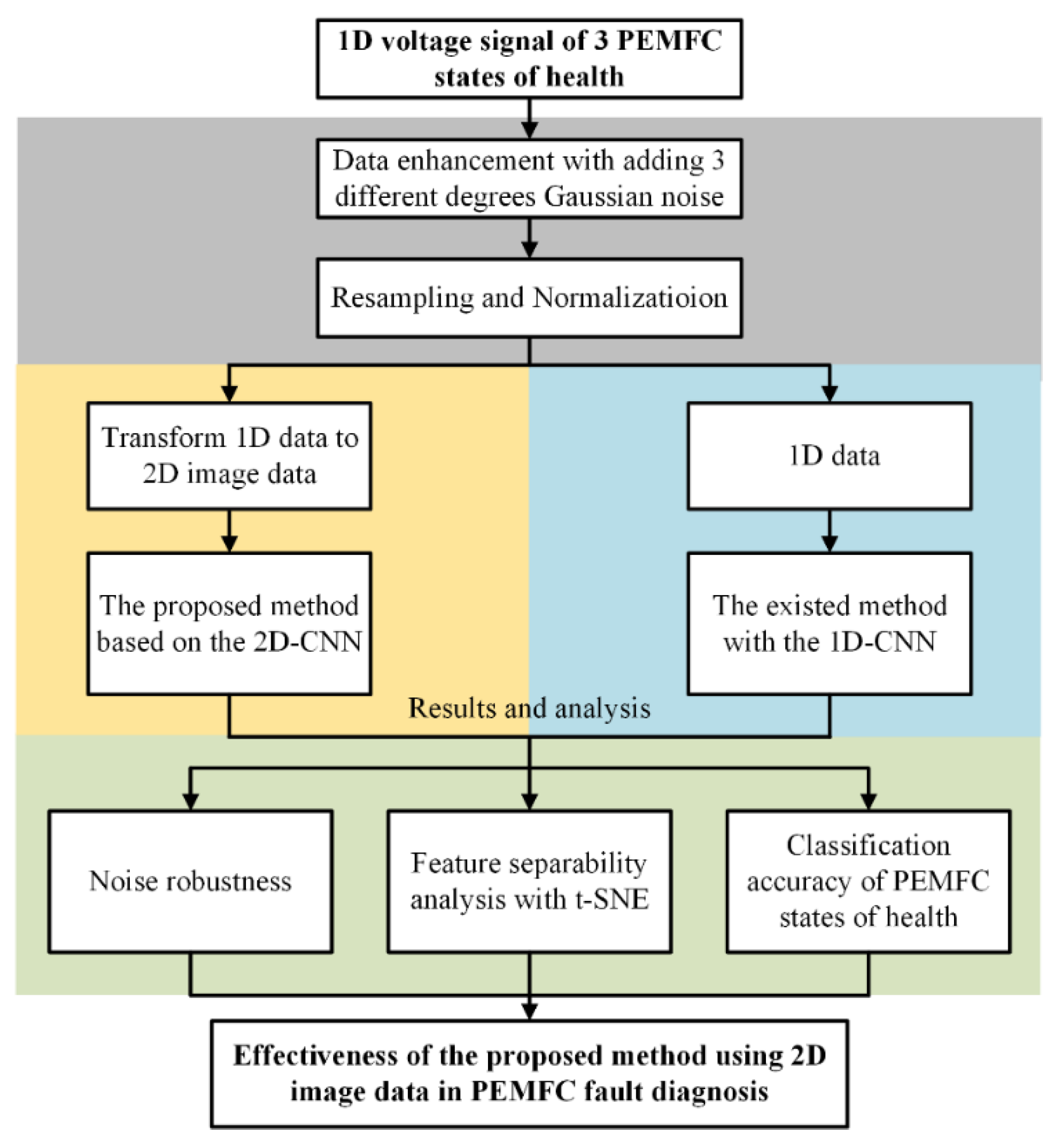
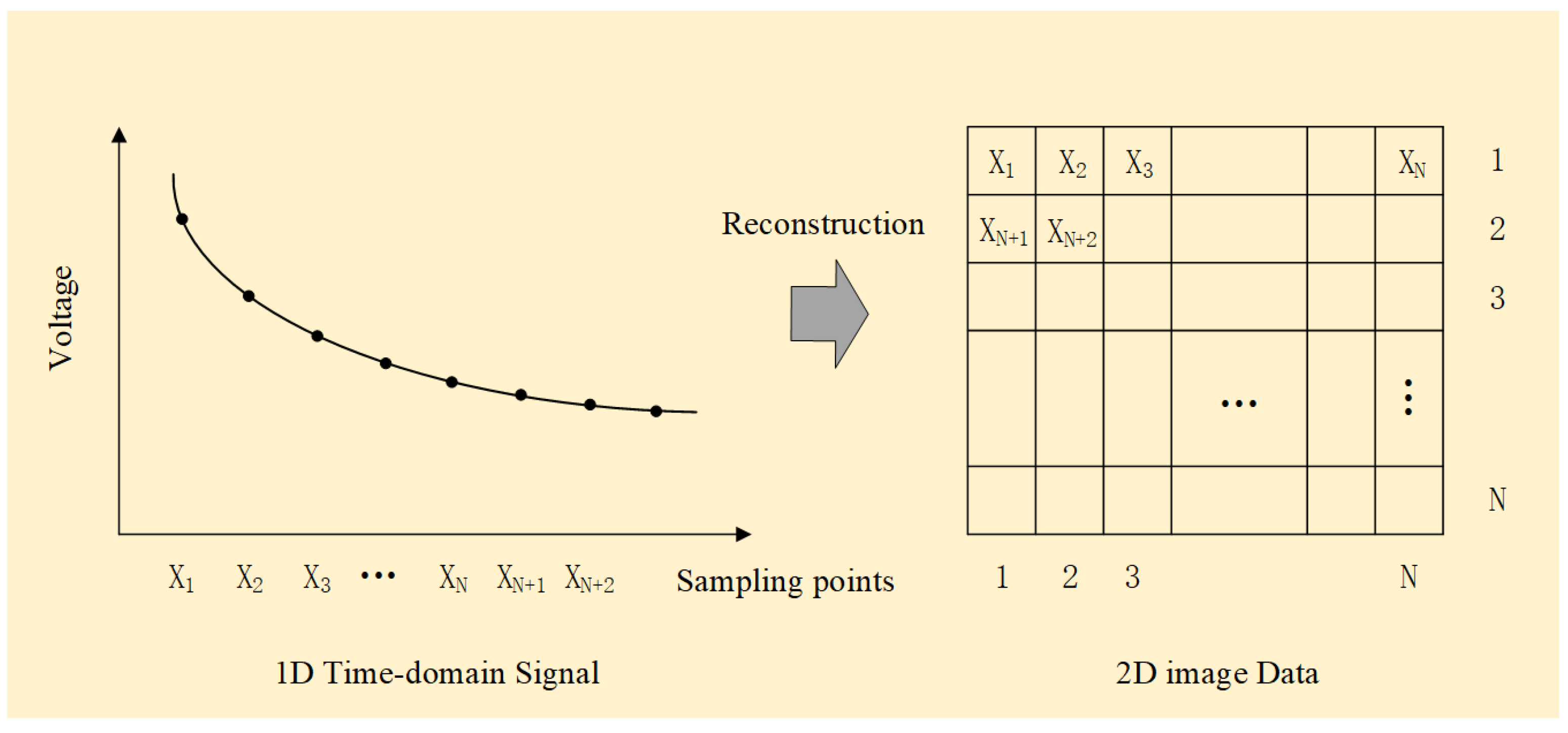

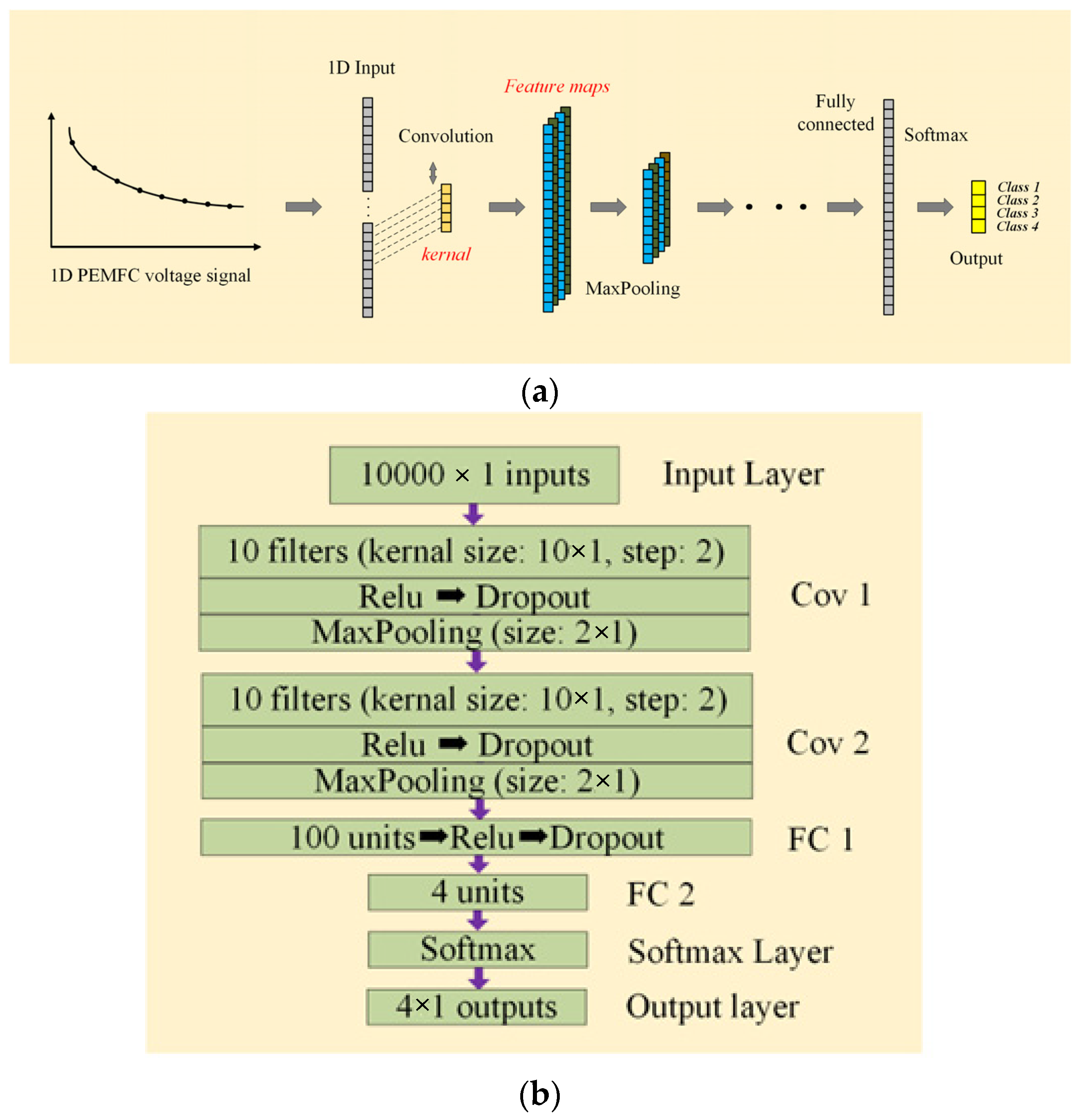
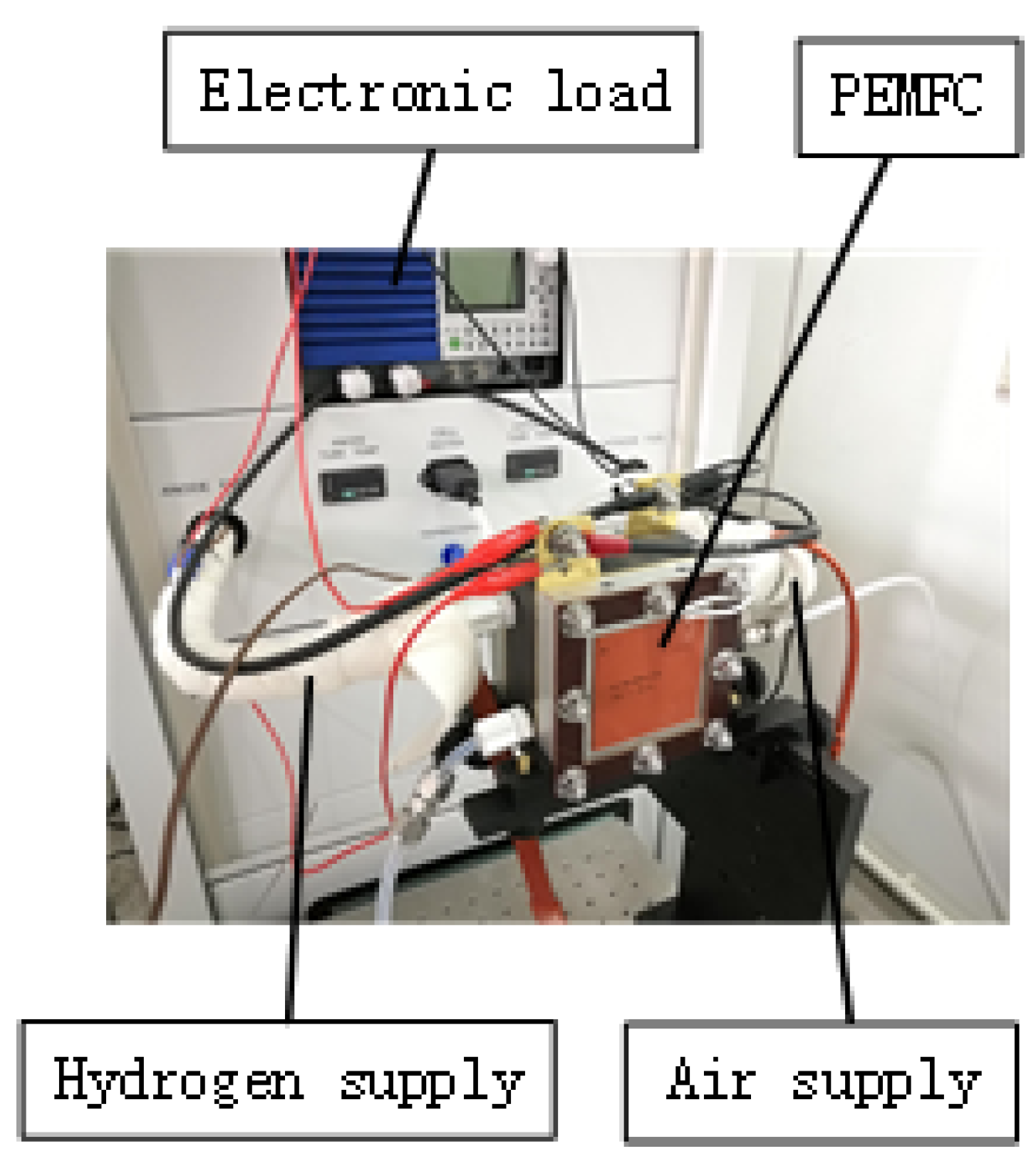
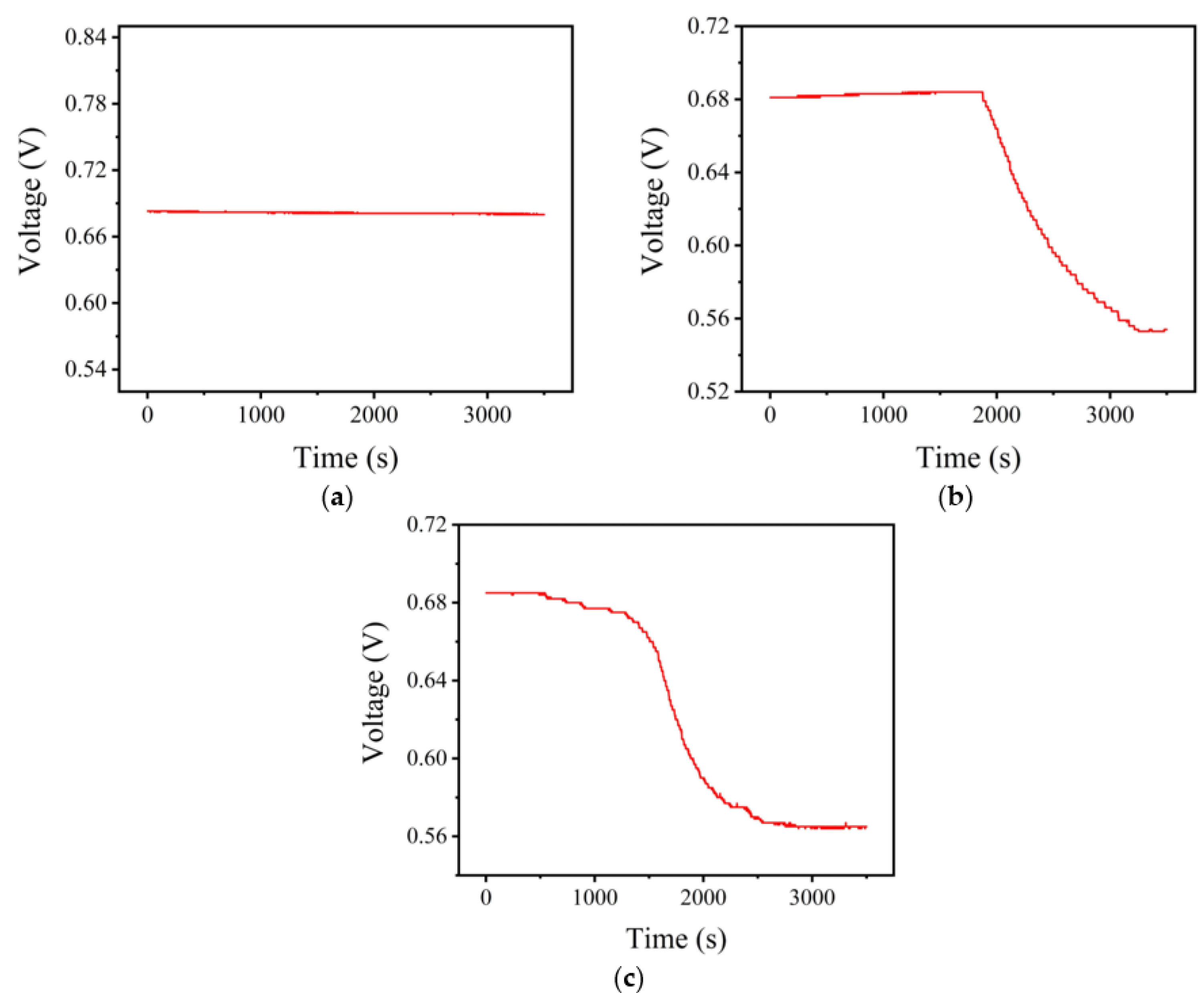

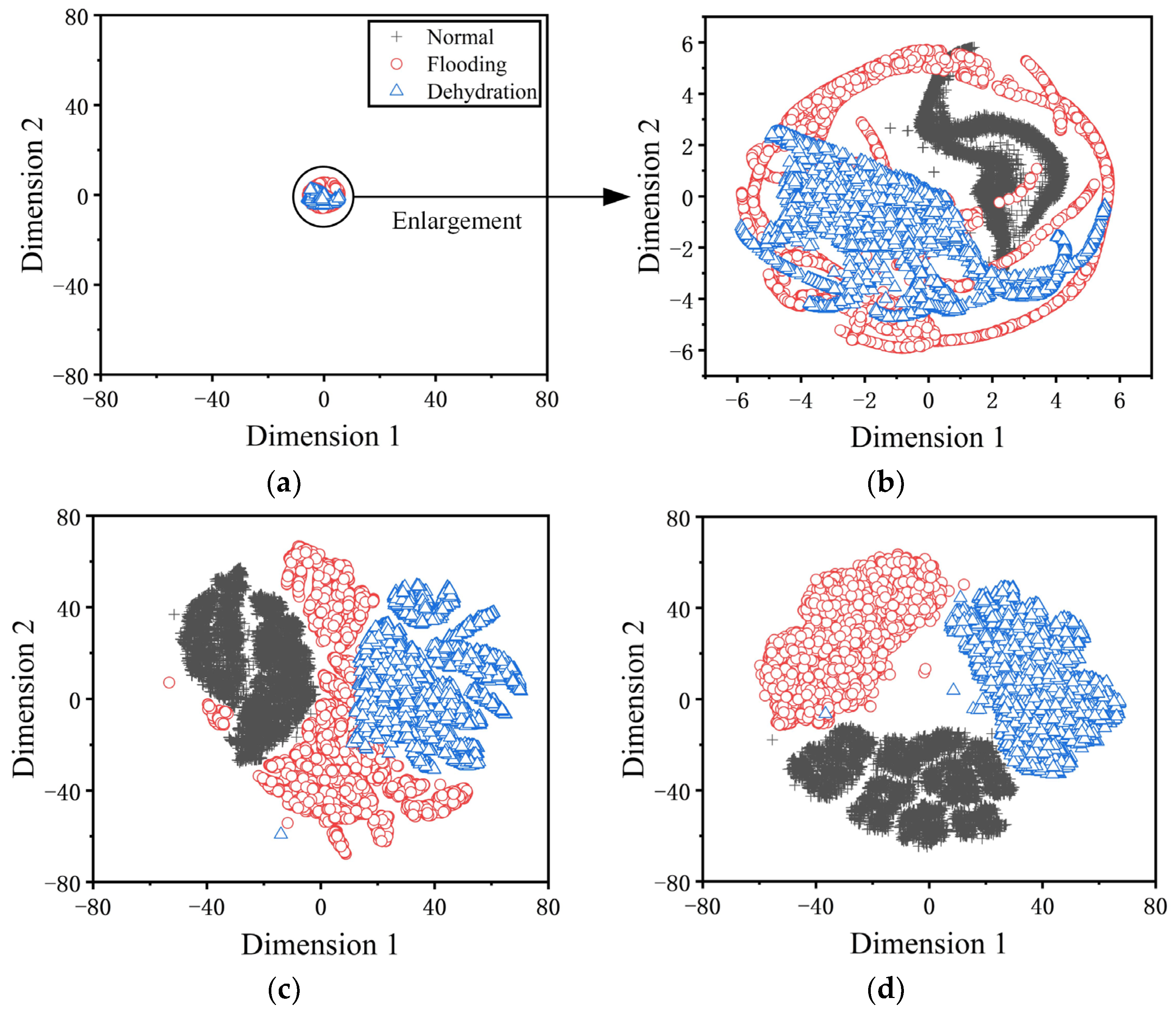
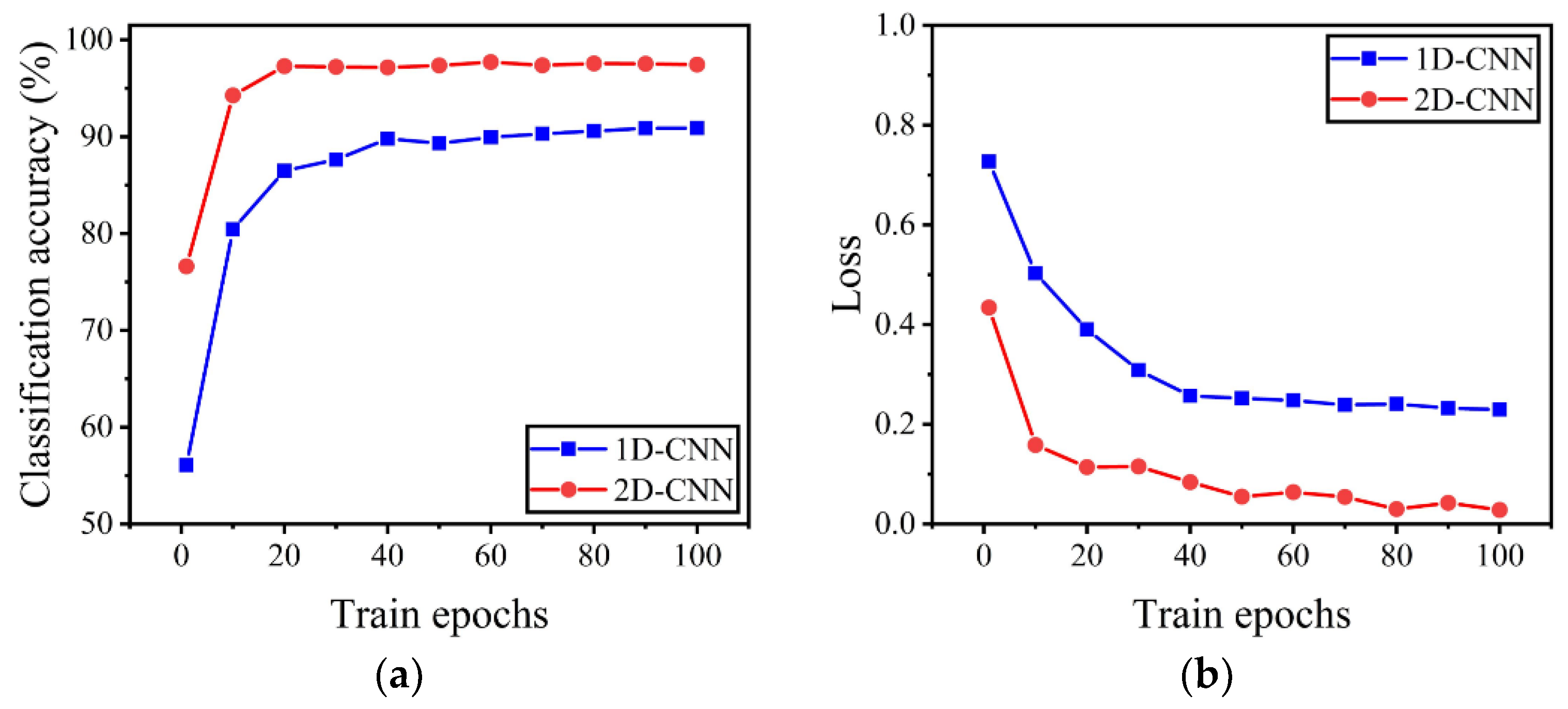
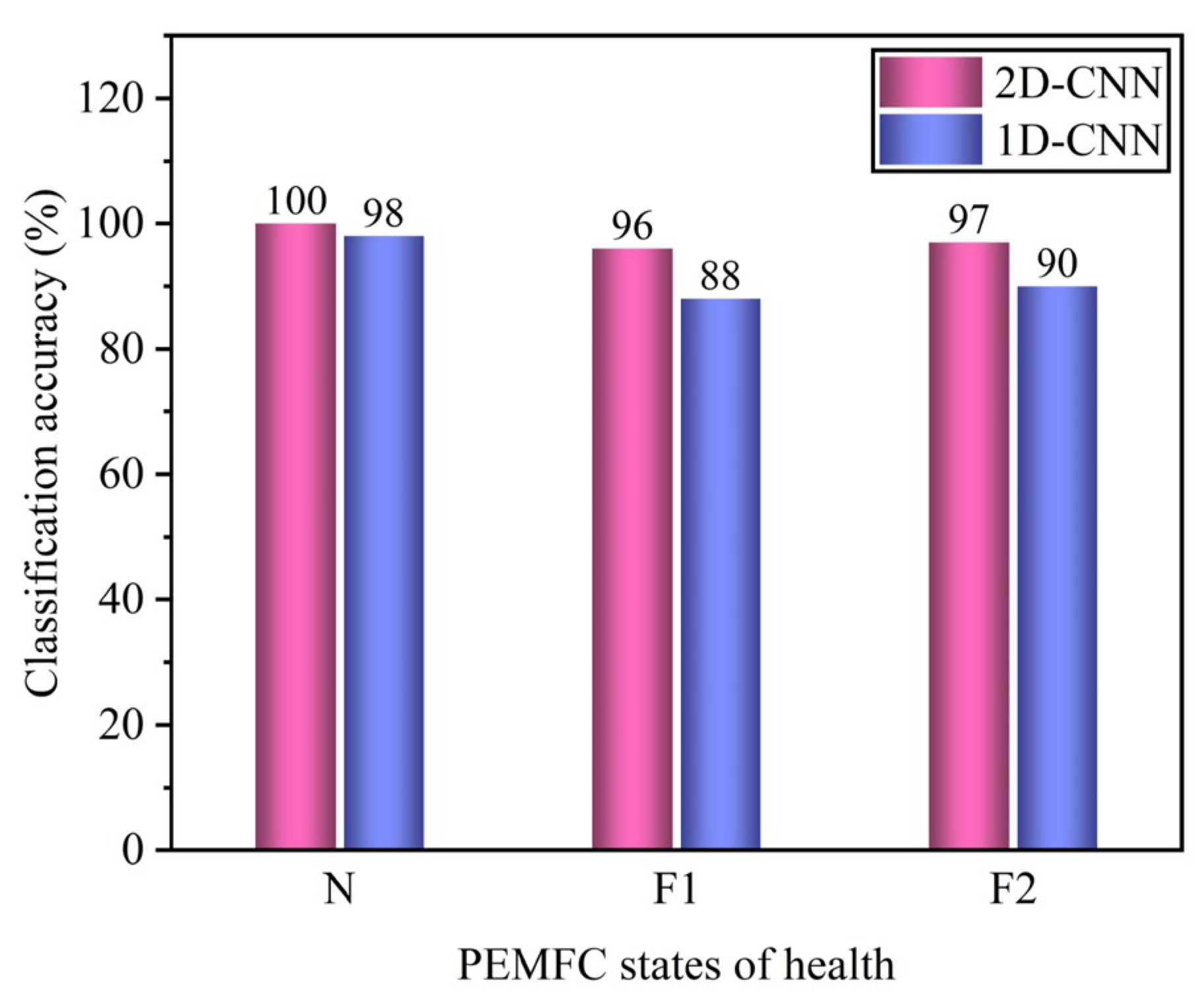
| Technical Parameter | MEA1 | MEA2 |
|---|---|---|
| Thickness of membrane (μm) | 15 | 18 |
| Surface area (cm2) | 25 | 25 |
| Loading of platinum (mg/cm2) | 0.15@anode, 0.35@cathode | 0.15@anode, 0.35@cathode |
| Thickness of gas diffusion layer (μm) | 260 | 250 |
| Catalyst | 45% Pt/C | 50% Pt/C |
| Porosity | >77% | >77% |
| Resistivity | <15 mOhm × cm2 @1MPa | <15 mOhm × cm2 @1MPa |
| Catalyst particle diameter (nm) | 6–8 | 3–5 |
| Control Parameter | Normal | Flooding | Dehydration |
|---|---|---|---|
| Cell temperature (°C) | 60 | 60 | 60 |
| Current density (A/cm2) | 0.6 | 0.6 | 0.6 |
| Air stoichiometric rate | 3.5 | 3.5 | 3.5 |
| Humidifier temperature (Anode and Cathode) | 60 | 75 | 60 |
| Noise States | N1 | N2 | N3 | N4 |
|---|---|---|---|---|
| Normal | 2400 | 2400 | 2400 | 2400 |
| Flooding | 2400 | 2400 | 2400 | 2400 |
| Dehydration | 2400 | 2400 | 2400 | 2400 |
| Total | 7200 | 7200 | 7200 | 7200 |
| Noise Models | N1 | N2 | N3 | N4 |
|---|---|---|---|---|
| 1D-CNN | 92.1% | 88.2% | 86.5% | 84.9% |
| 2D-CNN | 98.7% | 97.3% | 95.9% | 94.8% |
| Detail | N1 | N2 | N3 | N4 | Total |
|---|---|---|---|---|---|
| Number | 4800 | 4800 | 4800 | 4800 | 19,200 |
Publisher’s Note: MDPI stays neutral with regard to jurisdictional claims in published maps and institutional affiliations. |
© 2022 by the authors. Licensee MDPI, Basel, Switzerland. This article is an open access article distributed under the terms and conditions of the Creative Commons Attribution (CC BY) license (https://creativecommons.org/licenses/by/4.0/).
Share and Cite
Zhang, H.; Liu, Z.; Liu, W.; Mao, L. Diagnosing Improper Membrane Water Content in Proton Exchange Membrane Fuel Cell Using Two-Dimensional Convolutional Neural Network. Energies 2022, 15, 4247. https://doi.org/10.3390/en15124247
Zhang H, Liu Z, Liu W, Mao L. Diagnosing Improper Membrane Water Content in Proton Exchange Membrane Fuel Cell Using Two-Dimensional Convolutional Neural Network. Energies. 2022; 15(12):4247. https://doi.org/10.3390/en15124247
Chicago/Turabian StyleZhang, Heng, Zhongyong Liu, Weilai Liu, and Lei Mao. 2022. "Diagnosing Improper Membrane Water Content in Proton Exchange Membrane Fuel Cell Using Two-Dimensional Convolutional Neural Network" Energies 15, no. 12: 4247. https://doi.org/10.3390/en15124247
APA StyleZhang, H., Liu, Z., Liu, W., & Mao, L. (2022). Diagnosing Improper Membrane Water Content in Proton Exchange Membrane Fuel Cell Using Two-Dimensional Convolutional Neural Network. Energies, 15(12), 4247. https://doi.org/10.3390/en15124247







